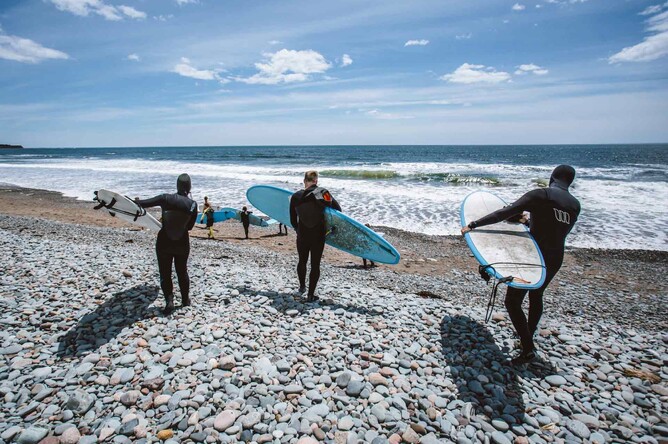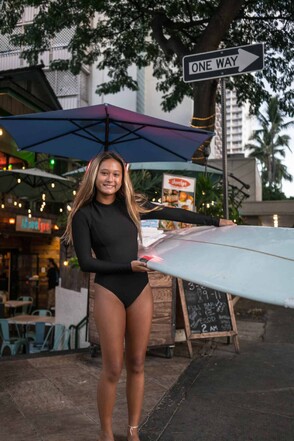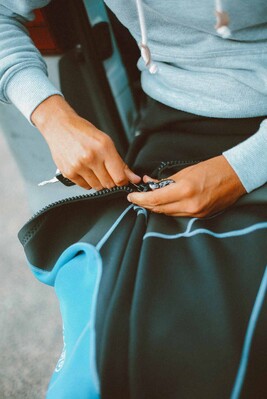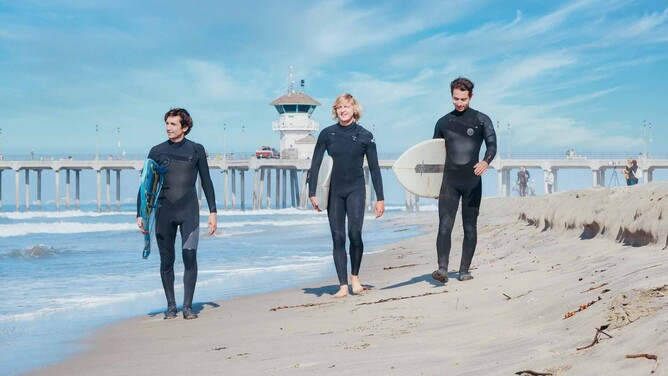There’s no way around it: if you want to be a cold water warrior, you’re going to need a wetsuit.
However, choosing the right wetsuit is easier said than done. There’s a lot to consider here, including the wetsuit’s thickness, neoprene quality, construction, zipper and fit - all of which can impact your comfort and performance in the water.
Not sure which wetsuit is right for you? We’ve got your back. We’ve rounded up everything you need to know about buying a wetsuit.
Get down with the thickness
Pretty much all wetsuits are made using neoprene, a synthetic rubber that keeps you warm by trapping a layer of water between your body and the wetsuit. Thanks to your body heat, this thin layer of water quickly gets warm, which helps you maintain a comfortable temperature.
With this in mind, thickness is one of the most important things to look at when choosing a wetsuit. Thickness is measured in millimeters, which is represented by one, two or three numbers separated by a slash.
- The first number represents the thickness of the neoprene around the torso area
- The second number represents the thickness of the neoprene in the extremities
- The third number, if it’s present, represents the thickness of the neoprene in the arms
Thicker neoprene is awesome for maintaining core body heat but is less flexible than thinner neoprene. And the opposite is true - thinner neoprene tends to be less warm but offers greater mobility.
Neoprene quality
Neoprenes are not all equal. Leading wetsuit brands constantly push development of neoprene to achieve more flexibility, lighter weight, and higher insulation qualities. Flexibility is key for free movement in action water sports. Lighter weight neoprene adds to the free movement. The addition of thermal layer fabrics to the inside of a wetsuit significantly improves insulation. As a general rule, you get what you pay for when it comes to Neoprene quality. The extra $ spent will result in warmth, flexibilty and comfort = longer sessions.
Choose a style
Wetsuits come in a few styles that are suited to different climates and conditions. These include:
- Full Wetsuit / Steamer: Covers your entire body, including your arms and legs.
- Full Wetsuit / Steamer Short Arm: Covers your body and legs with short arm sleeves
- Shorty/ Springsuit: Has short legs and either short or long arms, making it a good choice for the summer months and warmer climates.
- Short John: Covers just the body. Good for arm and shoulder freedom of movement
- Vests: Covers the upper body and has either long sleeves or no sleeves. Worm with board shorts or swimwear. Definitely a summer suit.
Check out our great range of wetsuits and boardring gear online. Not sure which type of wetsuit is right for you? Give us a call on 027 245 7540 and we’ll point you in the right direction.
Find the right fit
A wetsuit should feel like a second skin - nice and snug, but not so tight that it restricts your movement. Loose wetsuits allow too much water to flush through, which makes them less effective at keeping you warm. On the other hand, wetsuits that are too tight will limit your range of motion and put unnecessary stress on the seams.
What does a good fit look like? If it looks like the suit is painted on to your body, then it is perfect. In general, the neoprene shouldn’t be bunched up anywhere. If you’re wearing a full wetsuit, the sleeves should end at the wrists and the legs should fall to just above the ankle. Remember that the wetsuit will loosen up slightly in the water and will conform to your body shape better after a few uses. Our wetsuit Brands offer a range of extra sizes so we can find the best fit for you.
Zip it
Your choice of zipper mostly comes down to personal preference. You’ve got two main options. Zips cannot flex or stretch with the neoprene and movement of your body.
- Back zip: The traditional back zipper runs down the back of the wetsuit and has a pull cord attached. Back zips are generally the easiest to get in and out of, however being non stretch, effects movement and flexibility in the back area. Modern wetsuits have short back zips to minimize this.
- Front zip: Front zips usually run along the chest of the wetsuit. In this area they have minimal effect on flexibility. A front zip suit requires some technique to get in and out of compared with back zip wetsuits but are generally easy when used correctly. They also offer a more consistent seal around the collar.
Types of seams
In the never ending quest for greater flexibility, durability and watertightness, manufacturers have come up with a bunch of different ways of stitching together their wetsuits.
Flatlock: Simple and inexpensive, the flatlock seam involves stitching together the edges of two panels. Because the stitching goes through both panels, this is the least watertight seam and is more suited to thinner wetsuits used in warmer conditions.
Glued and blind stitched: Panel edges are glued together and then stitched. The stitching doesn’t penetrate both sides of the neoprene, creating a strong and watertight seam. Great for colder conditions.
Taped: Tape is applied to the inside of the glued and blind stitched seam to add extra strength, reduce chaffing and add to waterproofing. In some wetsuits, the tape is applied to every seam; in others, it’s used only on critical seams.
Liquid Seams: Flexible liquid glue is applied to seams (like a weld) to add extra strength, reduce chaffing and add to waterproofing. Liquid seams are used on critical seams and can be on the inside and outside of a wetsuit.
Talk to the wetsuit experts
If you’re looking for a new wetsuit, you’ve come to the right place. Here at Assault Boardriding Centre, we stock an awesome range of boardriding wetsuits that’ll keep you warm and comfy no matter the conditions.
Check out our wetsuits and boardring gear online or give us a call on 027 245 7540 to learn more.



